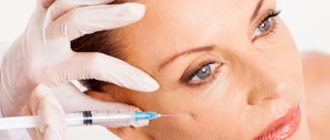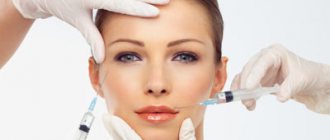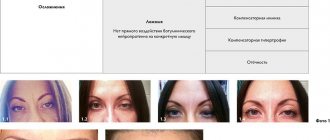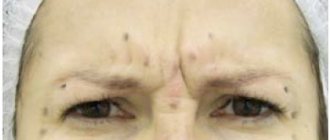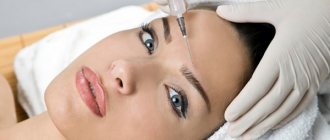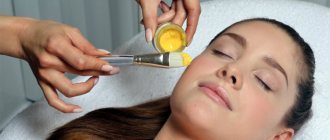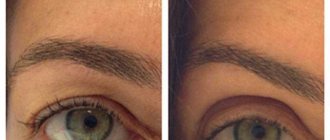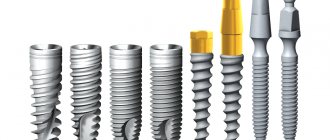“Critical days” for most women are a real punishment. At this time, the general condition worsens, sudden mood swings occur, swelling appears, and the skin often behaves strangely. Trying to minimize the risk of complications and side effects after anti-aging procedures, most cosmetologists try not to use invasive techniques during this period. Therefore, many believe that Botox and menstruation are categorically incompatible. Is it really?
Combination of Botox and menstruation
The introduction of botulinum toxin helps to block nerve endings and reduce the activity of facial muscles. Due to this, skin folds are reduced, wrinkles are smoothed out, and the woman looks younger.
During menstruation, a restructuring occurs in a woman’s body - a high concentration of hormones is released into the blood. This condition is accompanied by an increase in the sensitivity of the skin, a decrease in the body’s immune forces, and emotional lability.
Buyanov Sergey Yurievich (Expert Doctor):
The cyclical nature of processes occurring in the female body provides for cell rejuvenation. In the first phase they grow, in the second they mature. During monthly bleeding, they are rejected. In a state of rejection (from the uterus) and peeling (of the outer covering and mucous membranes), Botox injections have less effect, since the nerve endings are not ready to retain a sufficient amount of botulinum toxin.
Botox injections are not recommended during menstruation, as there is a risk of the following complications:
- active inflammation due to secondary infection;
- severe pain during and after injection;
- the appearance of compactions;
- allergic reaction in the form of rash, itching, swelling of soft tissues;
- displacement of the product due to active facial expressions and facial asymmetry.
The question of carrying out the procedure is decided only after consulting a doctor.
There is a whole list of more serious contraindications to botulinum therapy:
- pregnancy;
- lactation period;
- infectious damage to any organ;
- mental disorders that make a person dangerous to society;
- genetically or drug-induced bleeding disorder;
- diabetes mellitus type 1 or 2;
- status epilepticus;
- tendency to form keloid scars;
- exacerbation of chorionic disease, organ failure in the stage of decompensation;
- myasthenia gravis;
- tendency to have an allergic reaction;
- inflammation of the area where the injection was planned;
- ulcerative lesions, other violation of the integrity of the skin;
- tendency to seizures;
- taking antibacterial medications, hormonal substances.
Additionally, the sources indicate the age limit. After 65 years, the production of elastin and collagen is reduced to a minimum. Not a single “beauty injection” will give the effect that the patient expects. In this case, a facelift will help.
The essence of the procedure
The principle of operation of “beauty injections” is to administer a safe dosage of neurotoxin type A into the small muscles of the face. It is produced in the laboratory from botulinum produced by bacteria, weakened, purified and becomes the basis of modern drugs for the correction of wrinkles.
The toxin that enters the body comes into contact with neurons, and they stop producing the substance that conducts nerve impulses - acetylcholine. Without receiving commands from the brain, the muscles relax and even with an effort of will it becomes impossible to contract them. The skin, without constantly breaking at the sites of facial wrinkles, begins to regenerate and gradually smoothes out.
Fortunately, such blocking is temporary. Gradually, new processes appear on the blocked neurons and begin to produce acetylcholine again. Neural connections are restored, muscles regain the ability to contract.
Possible side effects
In addition to inflammation and allergies, other undesirable effects cannot be excluded, about which the patient must be warned in advance. The list includes:
- formation of hematomas due to compression of a small capillary by the agent;
- ptosis – drooping eyelid;
- displacement of a substance to another zone;
- excessive blocking of nerve endings, which causes a mask effect;
- swelling and redness of the skin.
Side effects are extremely rare, many of them can be avoided if you follow the recommendations for administering Botox and remember the restrictions that apply after the procedure.
Safety regulations
To minimize the possibility of harmful consequences for the body, those who decide to inject Botox during menstruation must adhere to the following recommendations:
- do not drink alcohol for at least 2-3 days before and after the procedure;
- limit coffee consumption to 1-2 cups per day;
- monitor the amount of fluid you drink - no more than 1.5 liters per day;
- do not sunbathe, do not visit the solarium and protect your face from the sun;
- do not overheat, do not steam in the bathroom or sauna;
- try to maintain the integrity of the skin as much as possible;
- limit physical activity.
For several hours after the injection of Botox, you should not take a horizontal position or even tilt your head forward. The wounds should be constantly treated with an antiseptic for the first two days. And if you experience pain, severe redness of the skin, large bruises and swelling, it is advisable to consult a doctor.
Botox injections before or after menstruation - which option is better?
So, when is it better to inject botulinum toxin - before or after menstruation?
From the point of view of the mechanism of action of Botox itself, its pharmacokinetics and pharmacodynamics, there is no difference; the drug will act in any case. All the nuances lie in the woman’s body.
If the procedure is carried out 24 hours before the start of menstruation, the girl, against the background of emotional lability, may react inadequately to painful sensations during the injection, ignore medical recommendations and at the same time remain dissatisfied with the cosmetologist and the clinic as a whole.
To protect yourself as much as possible and not cause problems to others, an experienced specialist clarifies the cycle and schedules a session after the end of your period.
Buyanov Sergey Yurievich (Expert Doctor):
It is more advisable to carry out any manipulations associated with external intervention in the first phase of the menstrual cycle at the moment most favorable for the female body. That is, 1-3 days after the end of menstruation.
For hair and eyelashes
In preparations for smoothing hair and eyelashes, the main active component - botulinum toxin - is absent. Although the procedure itself is also called “Botox”. But they contain many other chemicals and compounds that irritate the scalp, which determine a fairly long list of contraindications to these products.
It is also not recommended to perform them in the first days of the menstrual cycle. This is due to the increased activity of the sebaceous and sweat glands during “critical days.” The hair becomes oily faster, and the drugs cannot penetrate deep enough.
As a result, the effect of them does not last 6-8 weeks, as is normal, but only 3-4. Considering the fairly high cost of the procedure, it is better to wait a few days.
General recommendations
If side effects do occur, you should understand that if they are caused by menstruation, they will completely disappear within 2-3 days. If there is redness or discomfort, there is no need to panic; you need to be patient and wait for improvement.
If the clinical picture continues, and lumps form, or the condition worsens, you should immediately call a cosmetologist or come to him for an examination.
Trying to correct the situation on your own is prohibited - there is a risk of worsening your health, displacing the drug and complicating the doctor’s work.
If the area where the medication was administered is sprinkled, you should not squeeze out pimples - otherwise you can cause an infection and provoke the formation of pustules and infiltration seals.
There are so-called psychological nuances, which were already briefly mentioned earlier. The aggressiveness characteristic of women during this period affects satisfaction with the cosmetic procedure.
All minor troubles that occur in almost every patient (pain from injections caused by hormonal rise, bruises) can become a reason for complaints and negative reviews. To avoid such situations, it is better to postpone the procedure until next week.
Possible undesirable consequences of the procedure during this period
Most often, women undergoing botulinum therapy during menstruation complain of severe pain from injections. This is explained by the body’s increased sensitivity during menstrual periods and greater susceptibility to pain at this time. It is not surprising that even with the use of the thinnest needles, injections that are usually tolerated by the patient during menstruation cause her significant pain. Often, women even require preliminary anesthesia with lidocaine (usually this is done without injection, by simply lubricating the skin with an anesthetic solution).
Sometimes a woman with a low pain threshold will have to apply a local anesthetic.
Naturally, if the injections cause pain on normal days, then during menstruation they are likely to be even more painful.
On a note
It is believed that some Botox analogues - Relatox, Neuronox - are very painful when administered by themselves. Women feel pain when injected with these drugs even outside of menstruation. During menstruation, both the pain of such injections and the duration of pain can increase significantly.
The same is true for pain and itching that develops at injection sites after the procedure. These sensations are one of the most common side effects from Botox injections. If you give these injections during your period, the likelihood of such complications will be much higher.
It is also useful to read: Specifics of Botox injections into the chin and chewing muscles
Also, on critical days, the risk of other unpleasant sensations that occur after botulinum therapy increases. For example, the patient may experience the illusion of a foreign body under the skin, a feeling of tightness and constriction of the skin. Such effects persist for several days, after which they disappear completely.
Another consequence is swelling and hematomas at the sites of Botox injection. Like the previous side effect, they often occur when a woman is in a completely normal condition, but menstruation significantly increases the risk of their development. These defects are temporary, usually disappear in 2-3 days, but they spoil the impression of the procedure for many women and often provoke fear that they will persist for a long time.
Other consequences of botulinum therapy during menstruation occur much less frequently:
- Pimples and acne at injection sites;
- Flu-like syndrome is one of the most unpleasant. It is accompanied by signs of mild fever, leading to nasal congestion, sneezing and malaise. It goes away quite quickly and is not complicated;
- Allergy. As a rule, it has nothing to do with menstruation, but due to the weakened state of the woman, it can occur more pronouncedly than outside the period of menstruation.
An allergic reaction after botulinum toxin injection cannot be associated with menstruation.
It is important to understand that some of the listed consequences can develop even if they have not previously manifested themselves in a woman. In particular, if during previous procedures the injections were painless for the patient, then during menstruation they may well be accompanied by severe pain that persists for some time after the injections.
Since changes in a woman’s body during menstruation do not affect the activity of botulinum toxin in tissues, the frequency of facial defects from procedures at this time does not differ from the frequency of those that occur outside the timing of menstruation. If after the procedure the patient develops ptosis, a “sad face,” or asymmetry of the eyebrows or lips, the cause of the defect lies in the doctor’s mistakes, but has nothing to do with menstruation itself.
If a woman experiences a serious side effect (for example, eyelid ptosis), then this is a doctor’s mistake, and not the influence of menstruation.
Likewise, the effect of the injections and the speed of its onset practically do not depend in any way on menstruation. In women who undergo the procedure during this period, wrinkles disappear as quickly and for as long as when undergoing it in a normal state.
Review
I was also scared of all sorts of exacerbations if Botox is administered during menstruation. It's good that I didn't listen. I injected it exactly at the junction of PMS and menstruation, injected it in the morning, and things started in the evening. Nothing scary or special at all. Everything is exactly the same. The doctor warned that the injection might be painful, but everything was fine. She even suggested Xeomin because it is more purified than Botox and less likely to cause pain, but I decided to bear with it. I injected Botox all the time, so it’s better not to change. There was no pain, no hematomas or swelling. So there is nothing to be afraid of.
Kristina, Nizhny Novgorod
Opinion of cosmetologists
All experts say that Botox injection is a good method of treating and preventing deep expression wrinkles that occur after 30 years.
The problem is that, against the background of increased hormonal levels, some women do not feel their best, and using the product will only aggravate the course of their periods. That is why a preliminary consultation is required, during which the doctor collects a complete history of life and disease, conducts a general examination and reports all the nuances of using botulinum toxin.
Botulinum therapy is not a vital manipulation, so the patient can wait a week.
Botox for hair during menstrual periods
Restorative procedures using Botox are also popular for improving hairstyles. The two most common methods are when Botox is injected, and when it is rubbed in to improve hair health. In the first case, the effect lasts a little longer. But rubbing Botox into your hair can fill it with vitality for several weeks.
Not a single woman will refuse to have her hair radiate radiance, energy, strength, look luxurious and very young. All this is achievable with botulinum therapy. But is it possible to do Botox during your period? This is not stated unequivocally anywhere, but there are limitations to the procedure.
Both in injections and in rubbing, a drug is used that does not respond to surges of hormones. But during menstruation, the body very meticulously tries to cleanse itself. Work to free yourself from everything unnecessary is going on, including at the cellular levels. Therefore, the drug will be less able to penetrate into tissues.
Menstruation increases the activity of glands, including those that produce sebum. This natural lubricant protects hair well from external influences. Including Botox. Therefore, the effect of the procedure may be nullified due to the inability of the drug to penetrate deep into the dermis and hair structure.
